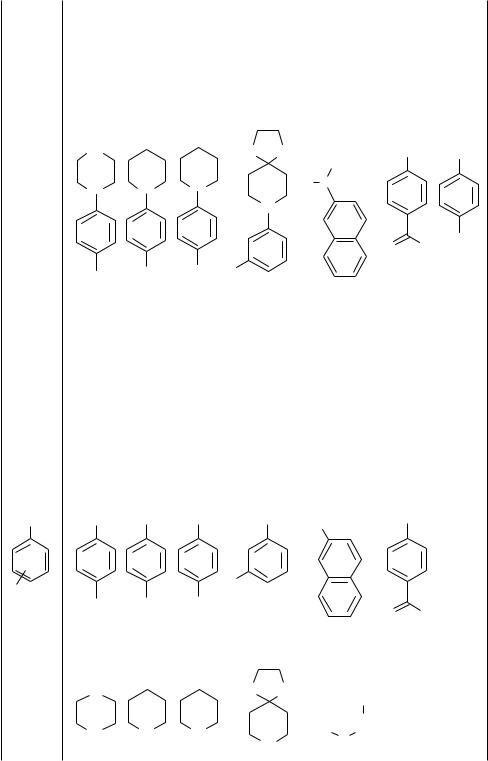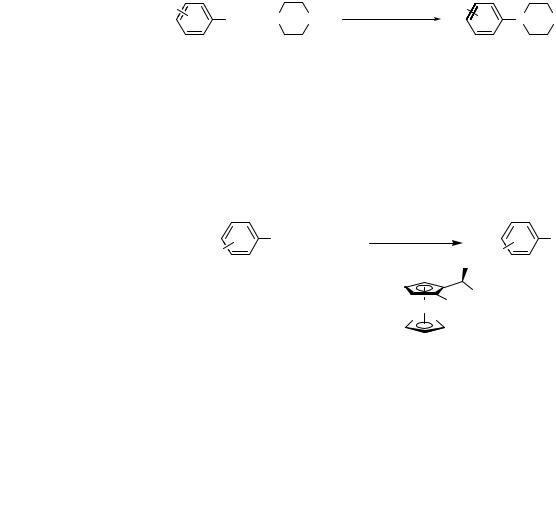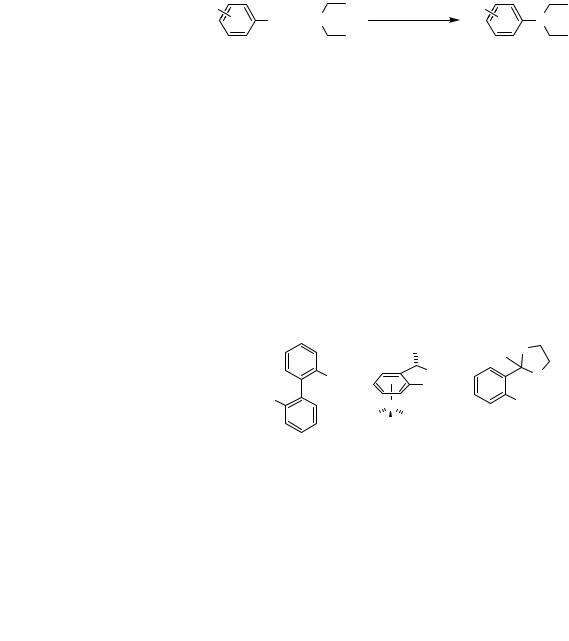

ArX |
Pd |
ArNR2 |
|
III.3.2 Palladium-Catalyzed Amination
of Aryl Halides and Related Reactions
JOHN F. HARTWIG
A. INTRODUCTION TO AMINATION
A.i. Cross-Coupling and Early Amination Studies
From reading the other sections of this book, one readily sees that palladium complexes serve as catalysts for a variety of C—C bond-forming cross-coupling processes. This cross-coupling chemistry involves the metal-catalyzed reactions between nucleophiles and electrophiles that display a wide variety of steric and electronic properties. It is, therefore, surprising that carbon–heteroatom bond formation by cross-coupling processes lay close to dormant until roughly five years ago.
There were a few isolated examples of coupling reactions that form C—P and C—S bonds.[1] Tunney and Stille had reported the Pd-catalyzed formation of the C—P bonds in aromatic phosphines,[2] and several groups had reported the formation of C—S bonds in sulfides using catalysts based on both palladium and nickel.[3]–[6] In addition there were suggestions that simple procedures for C—N bond formation could be developed and that palladium complexes could act as catalysts for C—N bond-forming cross-coupling processes. For example, Boger and co-workers used stoichiometric amounts of palladium to form aromatic C—N bonds in a -carbolide natural product by an intramolecular process (Eq. 1).[7]–[9] Perhaps more closely related to the work discussed in detail here,
MeO2C |
N CO2Me |
|
|
MeO2C N |
CO2Me |
H2N |
Me |
[Pd(PPh3)4] |
|
HN |
Me |
Br |
+ |
|
|
||
|
|
|
|
|
|
|
|
|
|
|
(1) |
R |
R |
[L2PdCl2] |
R |
|
|
Bu3Sn N |
+ |
|
NRR′ |
|
|
Br |
|
+ Bu3SnBr |
|||
R′ |
|
Only for |
|
|
|
|
|
L = P(o-C6H4Me)3 |
|
(2) |
|
|
|
|
|
|
|
Handbook of Organopalladium Chemistry for Organic Synthesis, Edited by Ei-ichi Negishi ISBN 0-471-31506-0 © 2002 John Wiley & Sons, Inc.
1051
1052 III Pd-CATALYZED CROSS-COUPLING
Kosugi and co-workers reported that palladium complexes with P(o-tolyl)3 as ligand would catalyze the formation of arylamines from aryl halides and aminostannanes (Eq. 2).[10],[11] A subsequent full paper demonstrated the scope and limitations of this chemistry. Although a small range of aromatic halides and aminostannanes were shown to undergo this process, the work of Kosugi and co-workers revealed one class of catalyst that could be used to form tertiary amines. It also demonstrated the potential for palladium chemistry to provide a general route to arylamines and other related compounds by aromatic C—N bond formation.
A.ii. Basic Principles
Some fundamental inorganic chemistry that is important for understanding which complexes will undergo the aromatic C—N and C—O bond-forming processes will be presented before the catalytic transformations. First, the three reaction types involved in the catalytic cycle to form arylamines are similar to those found in the catalytic cycle for C—C bond formation: oxidative addition of aryl halide to Pd(0) complexes, “transmetallation” that converts an arylpalladium halide complex to an arylpalladium amido complex, and reductive elimination to form a C—N or C—O bond. The oxidative addition step is identical to the addition that initiates C—C bond-forming cross- couplings,[12]–[ 1 5 ] but the steps that form the arylpalladium amido complexes and that produce the arylamine product are different. The mechanism for these steps is discussed after presentation of the scope of the amination process.
Several properties of amido and alkoxo complexes are different from those of alkyl complexes, and initially one might expect these properties to generate large differences in reactivity. First, amido groups are harder ligands than alkyls, and alkoxo groups are even harder than amides.[16],[17] Low-valent metal centers such as those in Pd(II) phosphine complexes are soft. This mismatch of the hard ligand with the soft Pd(II) center[18]–[20] had been predicted to produce highly reactive species, and low-valent amido and alkoxo complexes often resisted isolation and characterization.[16],[17] Most significant for the crosscoupling, it was believed that this class of amido or alkoxo complex would undergo rapid-hydrogen elimination to form metal hydrides. Indeed, reaction with basic alcohol solutions is a standard method for metal reduction.[16] Moreover, reductive eliminations of amines and ethers had not been observed prior to the work discussed in this section.
Second, amido and alkoxo ligands can act as -donors. This property, in combination with the presence of filled metal d orbitals, was another means to rationalize the typically high reactivity of late metal amido and alkoxo complexes.[17] Furthermore, the nitrogen and oxygen electron pairs allow these groups to act as efficient bridging ligands to generate multinuclear complexes. There are many bridging arylamido, hydroxo, and phenoxo complexes of late metal systems.[17],[21]–[24] Presumably, it is important to prevent formation of these dimeric complexes to observe efficient catalysis.[23]–[25]
Before considering the different types of amination reactions, one must also understand the structural aspects of phosphine ligands. Standard cone angles can predict steric properties,[26] but one must keep in mind that many conformations are possible for symmetrical phosphines and even more conformations are available for unsymmetrical phosphines, making it difficult to calculate a cone angle in many cases. The relative geometries of the two phosphines in chelating ligands is also important. “Natural bite angle” is a property that has been used to describe the P—Pd—P angle (more generally P—M—P).[27]–[29] In general, Pd(0) complexes adopt sterically preferred geometries such as tetrahedral, trigonal planar, or linear, because they are d10, and Pd(II) complexes prefer square planar or
III.3.2 Pd-CATALYZED AMINATION OF ARYL HALIDES AND RELATED REACTIONS |
1053 |
T-shaped geometries because they are d8. Thus, one Pd(0) or Pd(II) complex may be more or less stable than another because of the natural bite angle of the bisphosphine ligand. Of course, more complex phosphine ligands are available, including those with accompanying nitrogen or oxygen donors.
Phosphine electronic properties also vary widely. Alkylphosphines are stronger - donors than are arylphosphines, and arylphosphines of different donating ability have been created by changing substituents on the phosphine aromatic groups. The electronic properties of different phosphine ligands have been assessed by measuring the C—O stretching frequencies of Ni(CO)3L complexes.[26] However, it is difficult to assess how a particular change in stretching frequency will translate to differences in reactivity, and it is even more difficult to predict how these electronic perturbations will balance the relative rates of different steps in the catalytic cycle.[30] Nevertheless, this measurement provides a relative donating ability of different phosphine ligands.
A.iii. Classes of Amination Reactions
When choosing the appropriate catalyst for the amination processes, it is suitable to divide the types of substrates into categories. The amines can be divided into four categories: secondary alkylamines, secondary arylamines, primary alkylamines, and primary arylamines. Alkylamines can, of course, undergo -hydrogen elimination as intermediate palladium amides, while the arylamines cannot. Similarly, indoles, imines, hydrazones, primary amides, and carbamates cannot. These nitrogen nucleophiles can be divided into two classes: weakly nucleophilic reagents such as indoles, pyrroles, carbazoles, amides, and carbamates, and more strongly nucleophilic reagents such as hydrazones and imines. The aryl electrophiles can also be divided into categories with different reactivity patterns. Aryl iodides, bromides, and chlorides have dramatically different reactivity. Aryl triflates and tosylates should also be considered separately from halides because not all catalysts that react with aryl halides react with aryl triflates, and most do not react with aryl tosylates. Highly reactive aryl electrophiles bearing p-CN, p-C(O)R, or p-NO2 groups should also be considered separately from unactivated or deactivated aryl groups such as those bearing alkyl, alkoxy, and amino substituents.
The number of different ligands that can be used in amination chemistry is becoming bewildering. The intention of this review is to assist researchers wishing to conduct Pd-catalyzed aminations of aryl halides in their selection of a catalyst for a particular transformation. Although a synopsis of mechanistic data is provided in the final section, reviews with more detailed accounts of the mechanistic aspects of these reactions can be found elsewhere.[31]–[33] Several reviews of catalyst development for Pd-catalyzed amination have been published, and a review of Pd-catalyzed carbon–heteroatom bond formation has been published.[31],[34]–[37] However, catalyst development for these processes has been rapid, and this review contains several new systems and synthetic applications. This development is likely to continue in the near future. Thus, some comments and predictions are made by the author about certain transformations that are likely to be developed based on known synthetic and mechanistic information.
A.iv. Overview of Catalyst Selection
Table 1 provides a classification of the types of amination reactions and the classes of catalysts that are most appropriate for the different reactions. Of course, catalyst development is an ongoing and evolving area of research, and this table includes results with systems in

|
Carbamate/ |
Amide |
|
|
Indole |
|
|
Imine |
|
|
Hydrazone |
Formation |
|
2 Aryl |
C-NBond |
|
|
Aromatic |
|
2 Alkyl |
CatalystChoicefor |
|
1 Aryl |
TABLE1 SummaryofAppropriate |
N-substrate |
Ar-X 1 Alkyl |
Bu)-tP( |
PPh |
intramol. |
|
Bu)-tP( |
|
|
|
|
|
|
|
3 for |
|
|
3 |
|
|
|
|
|
|
|
|
|
3 |
|
|
|
|
|
|
|
|
|
|
3 |
|
|
|
3 |
|
|
|
|
|
|
|
P(t-Bu) |
DPPF |
|
|
P(t-Bu) |
|
|
|
|
|
|
|
DPPF |
BINAP |
|
|
|
|
|
|
|
|
|
|
DPPF |
BINAP |
|
|
|
|
|
|
BINAP |
|
|
BINAP |
3 |
|
3 |
|
3 |
|
|
|
|
|
|
|
P(t-Bu) |
DPPF |
P(o-tol) |
|
P(t-Bu) |
|
|
|
DPPF |
|
|
|
tP(-Bu) |
) |
BINAP |
oP(-tol) |
tP(-Bu) |
(4) |
DPPF |
BINAP |
BINAP |
DPPF |
D |
tP(-Bu) BINAP |
OMe-PPF (1 |
s’Guramligand ArPR |
||||||||||
3 |
|
|
3 |
3 |
) 2 ( |
|
|
|
|
BPF |
3 |
|
|
2 |
|
|
|
|
|||||
|
|
|
|
|
|
|
|
|
|
t |
|
Bu)-tP( |
DPPF |
DPEphos |
BINAP |
Bu)-tP( |
|
DPPF |
BINAP |
DPPF |
BINAP |
|
BINAP |
3 |
|
|
|
3 |
|
|
|
|
|
|
|
BINAP |
|
|
|
2 |
-tP(Bu) |
BINAP |
|
BINAP |
|
2 |
BINAP |
|
|
|
P(-PPFt-Bu) |
|
|
P(-PPFt-Bu) |
|||||
a |
|
|
|
|
3 |
|
|
|
|
|
|
ArBr |
|
|
|
ArCl |
|
ArI |
|
ArOTf |
|
ArOTs |
Heteroaryl-X |
diphenylphosphino)ferrocenyl]ethyl-[(2 ether;methyl
-1
1( =)
bis(diphenylphosphino)ferrocene;-' OMe-PPF
1,1=
-' DPPFbinaphthyl;
2,2= -' 1,1-bis(diphenylphosphino)
BINAP a
= dicyclohexy1
( )4b
ligand
butylphosphino)ferrocene;-t s’Guram
= -'1,1 -bis(di
D BPF-t
butylphopshine;-t
-diphenylphosphino)ferrocenyl]ethyldi
-1 -[(2
=
2 Bu)-t P(-PPF
biphenyl.-'
(2) = 2-dimethylamino-2'-dicyclohexylphoshino-1,1
2
-2 ArPRyl)phenyl]phosphine;
-1,3 -dioxolan
-[2 -(2 -methyl
1054

III.3.2 Pd-CATALYZED AMINATION OF ARYL HALIDES AND RELATED REACTIONS |
1055 |
the open literature by May 15, 1999, and some results in papers submitted by the author prior to this date. The ordering of ligands within each category is certainly subjective, and one ligand may be more or less effective within the categories for a particular substrate combination.
In general, arylphosphine ligands are suitable for reactions with aryl bromides, iodides, and activated aryl chlorides, but not for those with unactivated aryl chlorides. Furthermore, monophosphines tend to be less suitable ligands for amination of aryl triflates or tosylates than are chelating phosphines, although exceptions exist. Finally, it was originally believed that chelating ligands were necessary for reactions of halopyridines,[38] but amination chemistry with bromopyridines has now been accomplished with the simple monophosphine P(t-Bu)3.[39] In general, monophosphines can be used for reactions of aryl halides with secondary amines, and many reactions of acyclic or cyclic secondary amines with aryl halides occur in high yield when using catalysts bearing t-butylphosphines, such as those generated by a 1:1 ratio of P(t-Bu)3 and Pd(dba)2.[40] Although more expensive ligands that are commercially available in optically pure form give good yields for reactions of secondary amines,[41] their reaction rates are lower and they do not provide higher yields; similarly, the standard chelating ligands for aromatic C—N bond formation, BINAP and DPPF, provide no advantage over P(t-Bu)3 in most cases. In general, chelating ligands provide high yields for reactions with primary alkylamines or with arylamines.[42],[43] The chelating ligands tend to prevent rapid -hydrogen elimination by the primary amido intermediate,[23],[42] although reactions of primary amines with aryl halides can be conducted with t-butylphosphine ligands. The chelating ligands also tend to reduce diarylation of the primary amine.[43] Until recently, reactions of primary arylamines with aryl halides also required chelating phosphines. The reason for the success of these systems is unclear, but it has recently been shown that a 1:1 ratio of P(t-Bu)3/Pd(dba)2 will catalyze the amination of aryl bromides using primary arylamines at room temperature.[40]
B. SPECIFIC EXAMPLES OF AMINATION
B.i. Secondary Alkylamines
This section will cover the amination of secondary alkylamines, defined here as amines containing two alkyl groups or one alkyl and one aryl group bound to nitrogen. The reactions of secondary amines with aryl bromides, along with the reaction of primary amines with activated aryl bromides in the presence of stoichiometric amounts of base and a palladium catalyst containing P(o-tolyl)3 as ligand, were the first aminations of aryl halides that did not involve main-group amido reagents (Table 2).[44],[45] Under these conditions, one could prepare dialkylanilines from either cyclic or acyclic secondary amines at 80 °C in aromatic or ether solvents (Eq. 3). Reactions of cyclic secondary amines occurred in significantly higher yields with some aryl halides. Reactions using t-butoxide as base
X |
|
[L2PdCl2], L /Pd(OAc)2 |
X |
Br + HNRR′ |
or L /Pd(dba)2 |
||
|
L = P( o-C6H4Me)3 |
NRR′ |
|
|
|
|
|
|
|
base |
(3) |
X =o, m , or p- alkyl, phenacyl, amino, alkoxy base = NaO-t-Bu, or LiN(SiMe3)2

3 Me) 4 H 6 C-o (P
L
, 2 PdCl 2 Lby
TABLE 2. Initial Tin-Free Aminations of Aryl Halides Catalyzed
Yield (%)
Product
Base
Br
R
Amine
86 |
89 |
89 |
81 |
78 |
72 |
<2 |
O |
|
|
O |
O |
(CH |
NHhexyl |
NHBu |
|
|
|
|
|
Ar |
|
|
|
|
|
|
|
2 |
|
|
|
|
|
|
|
) |
|
|
|
|
|
|
|
2 |
|
|
N |
N |
N |
|
Me |
N |
|
|
|
|
|
|
N |
|
|
|
|
|
|
|
|
O |
Ph |
Bu |
Ph |
Bu |
MeO |
MeO |
|
|
|
|
-t-Bu |
2 |
2 |
NaO-t-Bu |
NaO-t-Bu |
NaO-t-Bu |
2 |
|
LiN(TMS) |
LiN(TMS) |
LiN(TMS) |
|||||
NaO |
Br |
Br |
Br |
Br |
Br |
|
Br |
|
Ph |
Bu |
MeO |
MeO |
|
O |
Ph |
R=Bu |
O |
|
|
O |
O |
|
|
Ar |
Nhexyl |
|
|
|
|
|
|
|
|
2 |
2 |
|
|
|
|
|
|
|
|
) |
|
NBu |
|
|
|
|
|
Me |
|
2 |
|
|
HN |
HN |
HN |
|
HN |
HN |
(CH |
H |
H |
|
|
|
|
|
|
|
|
|
2 |
|
1056

III.3.2 Pd-CATALYZED AMINATION OF ARYL HALIDES AND RELATED REACTIONS |
1057 |
occurred in higher yields than those with silylamide bases. Sodium counterion was important; lithium t-butoxide gave no reaction and potassium t-butoxide gave low yields and dark-colored reaction solutions.[44]
A second development in the formation of dialkylanilines was the use of chelating phosphines. For example, Hartwig and Buchwald concurrently reported the use of BINAP and DPPF for amination chemistry.[42],[43] These ligands are suitable for some amination chemistry with secondary alkyl amines. In some cases, turnover numbers were improved over the original system for the reactions of secondary amines with aryl bromides,[43] but the improvement in yield for reactions of secondary amines over that observed with the original catalyst system was modest. Moreover, the reactions of secondary amines using catalysts derived from BINAP and DPPF typically require higher catalyst loads and are less efficient than those developed subsequently containing t-butylmonophosphines. However, these catalysts did allow for reactions of secondary alkylamines with aryl iodides. Even after screening various reaction conditions, the original system was not particularly valuable for aminations of aryl iodides.[46] Most important for this section of the review, the catalysts with chelating ligands still gave variable yields for amination with acyclic secondary amines.
A remarkable advance was reported by Nishiyama, Yamamoto, and Koie, which involved the use of P(t-Bu)3 for the amination of cyclic secondary amines with high turnovers (Eq. 4).[39],[47] With this simple, commercially available ligand, they were able to obtain roughly 7000 turnover numbers for the amination of aryl bromides with piperazine, although at high temperatures. Little cross-coupling with this ligand had been reported previously, and this paper precedes the use of P(t-Bu)3 in other types of C—C bond-forming cross-coupling chemistry.[48]–[50]
X |
|
0.01 mol % Pd(OAc)2 |
X |
|
|
|
0.04 mol % P(t-Bu)3 |
|
|||
Br + HN |
NH |
N |
NH |
||
|
NaO-t-Bu |
|
120 °C |
73% conversion |
|
|
|
88% selectivity |
|
100% conversion with 0.02 mol % (4) |
The solution to the problem of catalysts for a general reaction of acyclic secondary amines with aryl halides began with the use of Kumada’s phosphinoether ligand 1 (Eq. 5).[41] With palladium catalysts bearing Kumada’s ligand, high yields were observed for this type of amination reaction. However, the ligand is extremely expensive in its commercially available optically pure form, and the synthesis is multistep. Nevertheless,
|
Br + HNRR′ |
[Pd2(dba)3]/L |
|||||
X |
|
|
|
|
|
||
R = alkyl, aryl |
NaO- t-Bu |
||||||
|
toluene, 80 °C |
||||||
X = 4-t-Bu |
|||||||
|
|
|
|
|
|||
|
4-OMe |
|
|
|
|
|
|
|
4-CN |
L = Fe |
|||||
|
3,5-Me2 |
|
|
|
|
|
|
|
|
|
|
|
|
||
or ArBr = 2, 3, or 4-pyridylbromide
NRR′
X
Me
52–93%
OMe
PPh3
1
(5)

1058 |
III Pd-CATALYZED CROSS-COUPLING |
this ligand led Buchwald’s group and Guram at Symyx to prepare more straightforward ligands with N and O donor atoms accompanying the phosphine. Biaryl-based P,N ligands containing alkyl substituents at phosphorus (2 in Figure 1) provided an efficient catalyst for this class of reaction.[51] Although perhaps simpler to prepare than Kumada’s systems, the preparation of these ligands was multistep and the ligand is susceptible to air oxidation. Guram prepared diphenylphosphino and dicyclohexylphosphinoether ligands 4a,b with phenyl backbones. These ligands are readily prepared in two steps from inexpensive 2-bromoacetophenone and provide high yields for reactions of cyclic and acyclic secondary amines.[52],[53]
Two other groups investigated P,N ligands for amination chemistry with secondary amines. Uemura and co-workers have prepared ligands similar to those of Kumada, but based on arene chromium complexes rather than ferrocenes.[54] Catalysts containing ligand 3 in Figure 1 provide good yields for some aminations with dialkylamines. For example, reactions of unactivated aryl halides with diethylamine, N-ethylaniline, or cyclohexyl ethylamine occurred in yields ranging from 73% to 90%. A P,N ligand with an imine nitrogen donor was prepared and used for amination by Arques and co-workers.[55] However, a single amination reaction was reported and it was run at 160 °C.
X |
1 mol % Pdn(dba)m |
|
X |
0.8 mol % P(t-Bu) |
3 |
||
|
Br + HN |
|
N |
NaO-t-Bu
room temperature
95–97% (6)
Thus, the least expensive catalyst system for low-temperature, high-yield amination of secondary amines, including acyclic secondary alkylamines, is one recently reported and based on Koie’s finding at high temperature. This system is conveniently generated by mixing a 1:0.8 ratio of Pdn(dba)m and P(t-Bu3)3 (Eq. 6).[40] Hartwig’s group reasoned that the use of this palladium precursor would avoid any loss of catalyst or ligand during reduction to Pd(0) and that a 1:1 ratio of ligand/palladium would ensure that the reaction solution was void of free ligand that inhibits the rate of the reaction. With this catalyst system containing commercially available components, room-temperature (r.t.) amination of aryl bromides was conducted with cyclic and acyclic secondary alkylamines in yields that are essentially quantitative. The full scope of this chemistry has not been explored— reactions of highly hindered aryl halides, heterocyclic halides, and branched secondary amines have not been conducted—but this simple catalyst system appears to provide a general catalyst for the reaction of aryl bromides with secondary alkylamines. One should be aware that the P(t-Bu)3 ligand is susceptible to air oxidation, although much more
|
Me |
|
O |
|
PCy2 |
|
NMe2 |
O |
|
|
PPh2 |
|
||
Me2N |
|
|
||
Cr |
|
PR2 |
||
2 |
3 |
|||
OC CO |
4a R = Ph |
|||
|
CO |
|
4b R = Cy |
|
|
|
|
Figure 1

III.3.2 Pd-CATALYZED AMINATION OF ARYL HALIDES AND RELATED REACTIONS |
1059 |
slowly than typical trialkylphosphines. Solutions (10%) of the ligand in hexanes are now avaiable from Strem in conventional or Sure/Seal packaging.
The amination of aryl chlorides is significantly more difficult than the amination of aryl bromides because of the decreased reactivity of chloroarenes.[56] Their low cost, however, makes them important substrates for mild coupling chemistry. In general, highly activated aryl chlorides such as 4-chlorobenzonitrile or 4-chlorobenzophenone react similarly to bromobenzene in the oxidative addition step, and the standard arylphosphine ligands are, therefore, suitable for Pd-catalyzed chemistry with these substrates. Indeed, the first amination of aryl chlorides was conducted with these activated substrates and the standard ligand systems.[57]
However, alkylphosphines are typically required for Pd-catalyzed reactions with unactivated aryl chlorides, and the first Pd-catalyzed amination of unactivated aryl chlorides employed PCy3 as ligand (Cy cyclohexyl).[58] Although good yields were observed in selected cases, the catalyst containing this ligand was not suitable for most amines. Thus, new ligand systems were sought for a more general catalyst to conduct aminations of aryl chlorides. Hartwig’s group prepared a t-butyl analog of DPPF, DtBPF (1,1-bis-di-t- butylphosphinoferrocene), which demonstrated that sterically hindered alkylphosphines were particularly well suited for the amination of aryl bromides at low temperatures and for the aminations of aryl chlorides at temperatures more reasonable for chemistry of functionalized molecules than the typical 140 °C required for other types of Pd-catalyzed chemistry with aryl chlorides.[59] Using ligand 2 described above, Buchwald and coworkers reported the amination of unactivated aryl chlorides with secondary amines at temperatures as low as 70–80 °C, and the amination of highly activated aryl chlorides at room temperature (Eq. 7).[51]
X |
R |
1–4 mol % Pdn(dba)m |
X |
R |
|
|
L |
||||
Cl + |
HN |
NaO- t-Bu |
|
N |
|
|
R |
|
R |
||
|
70 |
°C |
|
||
L = P(t -Bu)3 or 2 |
|
|
|
||
|
|
|
|
(7) |
|
Again, the simple catalyst system of Pd(dba)2 and P(t-Bu)3 in a 1:1 ratio allowed for the amination of unactivated aryl chlorides with cyclic or acyclic secondary amines at 70 °C using 1–5 mol % of catalyst (Eq. 7).[40] Catalyst loads that are lower by an order of magnitude can be used at 100–110 °C.[60] The reactions of activated aryl chlorides occurred at room temperature.
The amination of aryl sulfonates did not occur with the aryl monophosphines that were used originally for aryl halide amination. Instead, it was the use of chelating phosphines that first allowed for the amination of aryl triflates.[61]–[63] The procedures used originally, t-butoxide base and either BINAP or DPPF as ligand, allowed for the amination of aryl triflates in good yields in many cases, as summarized in Eq. 8. However, cleavage of the triflate to phenol competed with amination, particularly in the case of electron-poor aryl triflates. The yields of these reactions were improved in two ways. First, slow addition of triflate to ensure low concentration of this reagent improved yields in some cases.[61] More generally, the use of Cs2CO3 as base allowed for the reaction to occur smoothly without triflate cleavage (Eq. 9).[63] The arylpalladium triflate intermediate probably coordinates amine more readily than the arylpalladium halide complexes

1060 |
III Pd-CATALYZED CROSS-COUPLING |
because of the lability of the triflate ligand. If this occurs, amine coordination to a cationic metal center will significantly increase the acidity of the N—H bond, and a weaker base can be used.
|
|
L2/[Pd(dba)2] |
|
|
|
|
R |
or [Pd2(dba)3] |
|
R |
|
|
NaO- t-Bu |
|
|
||
OTf + HN |
|
N |
|
||
toluene |
|
|
|||
Y |
R |
|
Y |
R |
|
85 °C |
|
||||
Y = o, m , or p -alkyl, CN, C(0)Ph, OMe, Ph |
53–90% |
|
|||
|
|
||||
L2 = DPPF or BINAP |
|
|
|
|
|
|
Pd(OAc)2 /BINAP |
|
|
|
|
OTf + |
HRR′ |
Cs2CO3 |
|
NH |
|
toluene |
|
|
|||
|
|
Y |
R |
|
|
Y |
|
85 °C |
|
||
Y = o -alkyl, p-CN, |
p-C(0)Ph, |
|
|
54–92% |
|
p, o -C(0)Me, p-OMe |
|
for dialkylamines |
|
||
(8)
(9)
B.ii. Choice of Base
The strong NaO-t-Bu base used in the standard amination conditions can limit the types of substrates that are suitable for this chemistry. For example, reagents containing nitroarenes, enolizable hydrogens, and labile esters are unsuitable. For this reason, Buchwald’s group sought amination procedures that used weaker bases (Eq. 10).[64] As discussed in the preceding paragraph, the reactions of amines with aryl triflates instead of aryl halides allows for the use of Cs2CO3 as base. Furthermore, reactions of activated aryl halides can be conducted using Cs2CO3 as base instead of t-butoxide, without requiring a change of catalyst. However, reactions of unactivated aryl halides with this weaker base requires a different catalyst. Catalysts containing Kumada’s P,O ligand first allowed for aminations of unactivated aryl halides using Cs2CO3 as base.[64] More recently, Buchwald has used biaryl P,N ligands for the amination of aryl halides using Cs2CO3 and the less expensive and less toxic K3PO4.[51] Finally, Hartwig showed that the catalyst containing commercially available P(t-Bu)3 allows for the reaction of unactivated aryl bromides with secondary amines using Cs2CO3 or K3PO4 as base.[40] Thus, monophosphines appear to generate the most active catalysts for reactions using the weaker bases.
|
R |
1–4 mol % Pdn(dba)m |
|
R |
|
|
L =1, 2, or P( t-Bu)3 |
X |
|||
R |
Br + HN |
N |
|||
|
|
||||
|
R |
Cs2CO3 or K3PO4 |
|
R |
|
|
|
80–100 °C |
|
|
|
R = p-But, p-OMe, C(O)Me, C(O)OMe , base = Cs2CO3 |
for L = 1 |
||||
R = C(O)OMe, C(O)Me, base = K3PO4 for L = 2 |
|
|
|||
R = Me, base = K3PO4 or Cs2CO3 for P( t-Bu)3 |
|
(10) |
|||
